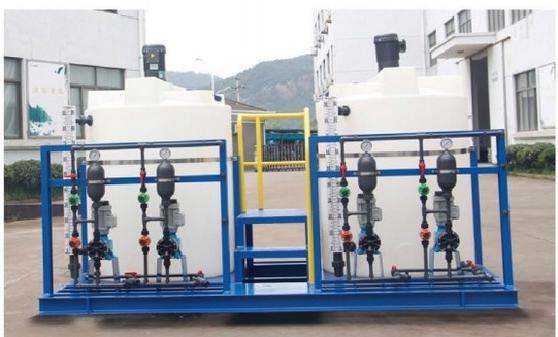close
Choose Your Site
Global
Social Media
loading















Process Principle

 Sodium hypochlorite solution is generally a pale yellow, transparent liquid. It is a strong oxidizing agent and a highly effective chlorine-containing disinfectant. Its bactericidal action includes the action of hypochlorous acid, the action of nascent oxygen, and chlorination. The oxidizing action of hypochlorous acid is the most important bactericidal mechanism of chlorine-containing disinfectants. Chlorine-containing disinfectants form hypochlorous acid in water, which acts on bacterial proteins. Hypochlorous acid can not only interact with the cell wall, but also, due to its small molecular size and lack of charge, it can penetrate into the cell and oxidize proteins or destroy their phosphate dehydrogenases, causing disordered sugar metabolism and leading to cell death.
Sodium hypochlorite solution is generally a pale yellow, transparent liquid. It is a strong oxidizing agent and a highly effective chlorine-containing disinfectant. Its bactericidal action includes the action of hypochlorous acid, the action of nascent oxygen, and chlorination. The oxidizing action of hypochlorous acid is the most important bactericidal mechanism of chlorine-containing disinfectants. Chlorine-containing disinfectants form hypochlorous acid in water, which acts on bacterial proteins. Hypochlorous acid can not only interact with the cell wall, but also, due to its small molecular size and lack of charge, it can penetrate into the cell and oxidize proteins or destroy their phosphate dehydrogenases, causing disordered sugar metabolism and leading to cell death.
R-NH-R+HC¹⁰→RNC+H₂O (bacterial protein)
The higher the concentration of sodium hypochlorite and the longer the contact time, the stronger the bactericidal effect and the better the result.
Sodium hypochlorite can also dissociate into hypochlorous acid in water:
NAC¹⁰ + H₂O → NaOH + HC¹⁰
Therefore, sodium hypochlorite solution is a highly effective disinfectant.
Equipment Introduction
Sodium hypochlorite dosing unit mainly consists of tanker interface and pipeline, unloading pump, and blue/yellow PE. Storage tank, level gauge, electric valve, metering pump, Y-type It consists of filters, safety valves , back pressure valves, ball valves, detection instruments, and electrical control systems. Optional instruments include electromagnetic flow meters and residual chlorine detectors.
In applications where sodium hypochlorite is used in large quantities, it is typically transported by tank truck. After docking via a quick-connect interface, the sodium is pumped to the storage tank by an unloading pump. When dosing is required , if the dosing system is in automatic operation, the automatic control system receives the dosing command signal, calculates the dosage, and sends the dosing command to the metering pump via the controller, thus achieving precise, on-demand dosing control.
Sodium hypochlorite dosing equipment can be installed on-site or supplied as a complete set.
Application areas
Sodium hypochlorite is mainly used in many fields such as bleaching, industrial wastewater treatment, papermaking, textiles, pharmaceuticals, fine chemicals, and sanitation disinfection. Sodium hypochlorite disinfectant is suitable for medical and health care, finance, tourism, government agencies, restaurants, pharmacies, hotels, shopping malls, schools, kindergartens, supermarkets, nail salons, beauty salons, massage parlors , bath centers, university campuses and internet cafes, food, drug and medical supplies manufacturing enterprises, homes and offices, small and medium-sized food processing plants, farms, and planting industries .
Data parameters
regulation grid type Number | Configuration parameters | Control method | |||
Volume (L) | Pump and tank configuration | Material | External dimensions L×W×H (mm) | ||
CTD-1□□/10□ |
30-20000 | 1 barrel 1 pump |
PP, PE, Fiberglass , UPVC | Minimum: 350×350×400 Maximum: 3150×3150×3350 | Manual button/automatic instrument control /PLC Touch Control/DCS Remote Control /GPRS wireless/Special requirements Calculate (flow rate, residual chlorine, (e.g., frequency converters). Power supply: 220V/380V 50Hz |
CTO-10□/2□□ | 1 barrel 2 pumps | Minimum: 350×350×400 Maximum: 3150×3150×3350 | |||
CTD-2□□/1□□ | 2 barrels and 1 pump | Minimum: 700×500×400 Maximum: 6900×3500×3350 | |||
CTD-2□□/2□□ | 2 barrels 2 pumps | Minimum: 700×500×400 Maximum: 6900×3500×3350 | |||
CTO-2□□/3□□ | 2 barrels 3 pumps | Minimum: 700×500×400 Maximum: 6900×3500×3350 | |||
